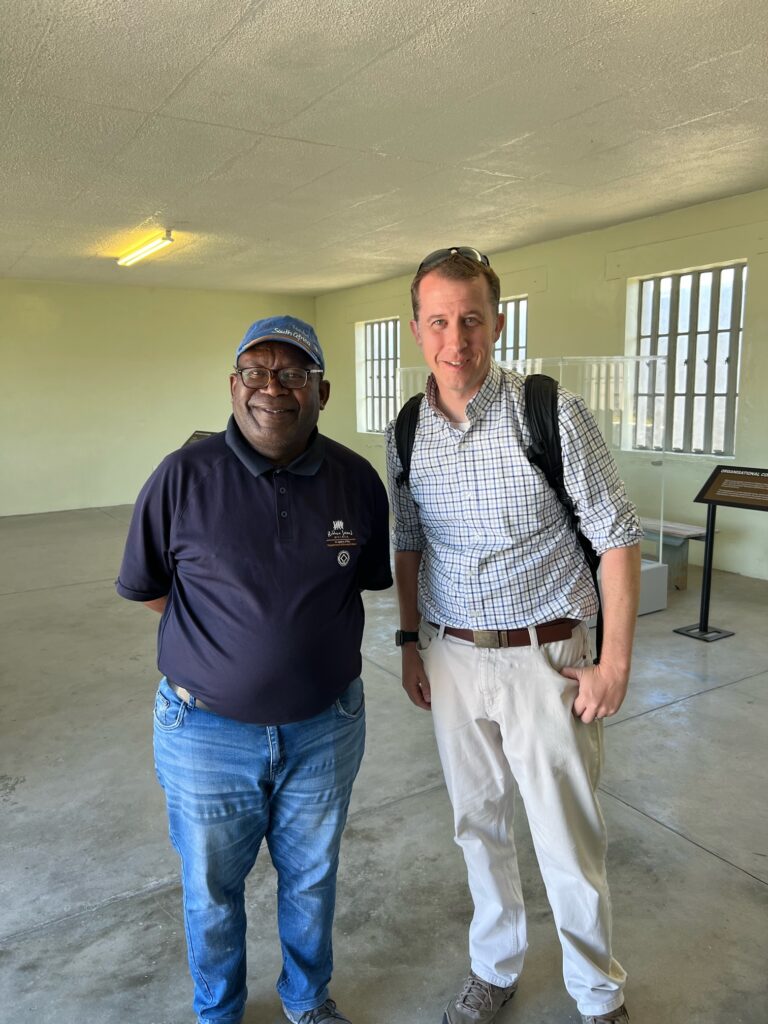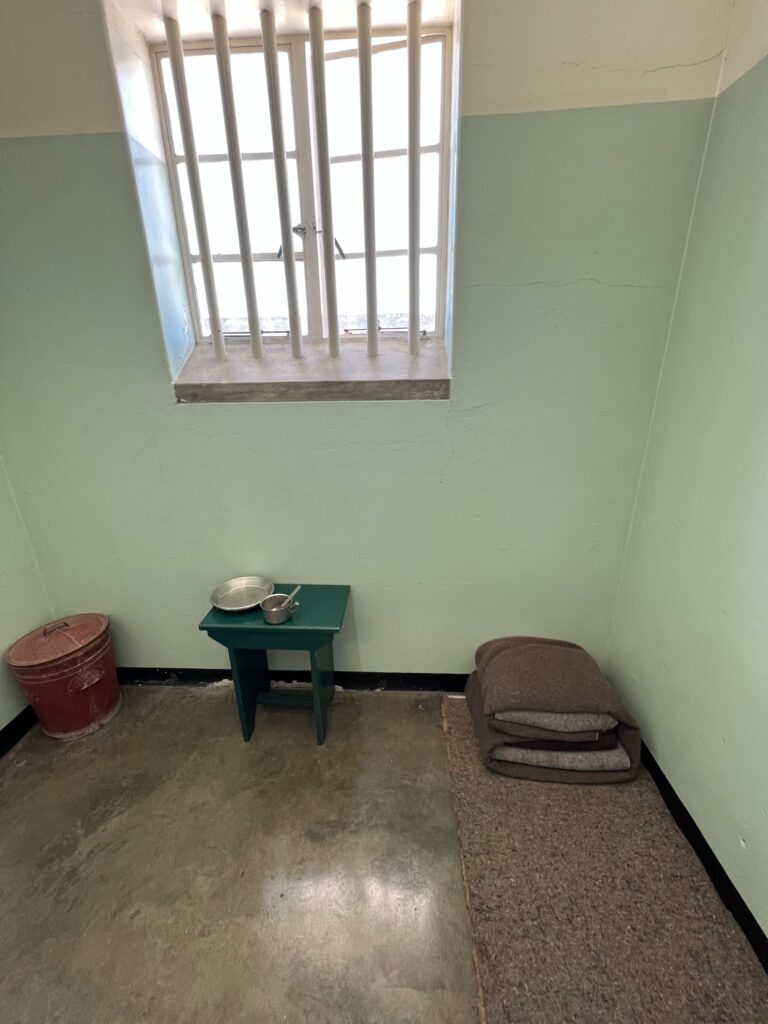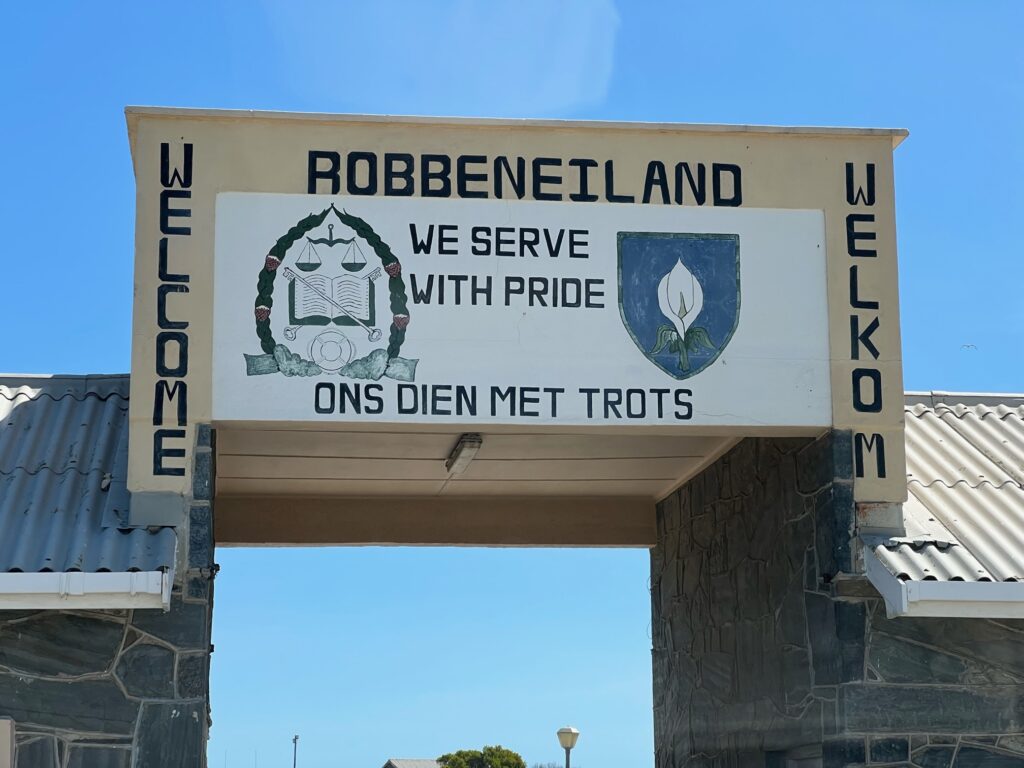Sabbatical Notes from Pastor Stephen: Cape Town #2
October 7, 2022


Today I had the profound experience of visiting Robben Island and was guided around the island and prison by a former political prisoner named Kgotso. If you’re wondering why it is named Robben Island, the word ‘Robben’ is the Dutch word for seal, named after a large colony of seals that once populated the land.
Robben Island is acknowledged for its great political symbolism as a place of selfless struggle and as a place signifying the triumph of the human spirit over great adversity. The Island is a space of memory with a rich and layered history going back 10,000 years. It’s actually the top of an undersea mountain! Its recorded memory and history of interaction with the outside world is said to have begun with the arrival of Vasco da Gama in 1498.
Robben Island has a chequered history of maritime contacts, confinement and banishment, oppression and hard labour, torture, segregation and discrimination. It has also been a military post, World War Two garrison, leprosarium and mental health facility, a prison for common law criminals and for political prisoners. Very few places in the world have such a long and layered history of human suffering, the fight for freedom of the mind and the body, and of subsequent triumph.
Robben Island is most famous for being a maximum-security prison for anti-apartheid political leaders from 1961 to 1991. After the political prison was shut down, the island became a museum for visitors and tourists to pay homage to the resilient leaders who fought for South Africa’s democratic society.
The prison was notorious for its harsh conditions and cruel treatment of prisoners. The prisoners had to comply with Robben Island maximum security structures and were forced to do tasks such as breaking rocks into gravel under harsh weather conditions. Prisoners were kept in solitary confinement which was primarily used as a means of punishment and torture.
While working in the limestone quarry was arduous, many prisoners saw it as a blessing. Mandela said the quarry would become their university. Since so many prisoners were lawyers, professors, and doctors, they could teach the other prisoners while working alongside them. Many prisoners preferred the work with one another over being alone in their cell.
Robben Island is famous for the many anti-apartheid freedom fighters incarcerated there. Members of the ANC, PAC and other organisations including the SA Congress of Trade Unions, National Liberation Front and the Communist Party were imprisoned on Robben Island for their anti-apartheid activism.
One prisoner, Robert Sobukwe, eventually became a detainee rather than a prisoner and was kept in a house on the island. The government didn’t want him to go free so added a clause to a law just for him to keep him detained. It was called the Sobukwe clause. He was a leader of the PAC.
In 1964, famous anti-struggle figures, Nelson Mandela, Walter Sisulu, Govan Mbeki and other ANC leaders were sent to imprisonment on the island. Mandela spent 18 of his 27 years of incarceration there before being elected as the country’s first democratic president. After decades of grueling incarceration, finally, in 1991, following the unbanning of political organizations in 1990, all political prisoners were granted freedom and were released from Robben Island.
I had some time in Mandela’s small cell. It’s fixed up from what it originally looked like. My guide showed me another cell that was more authentic looking with chipped paint. Originally there were no glass windows, just bars, on the one window looking into the courtyard so all the elements came into the cell.
What amazes me is the power of hope in those incarcerated there. It is mind boggling that these political prisoners could endure years of harsh conditions and torture to still be strong enough in mind, body, and spirit to help usher South Africa into a new democracy and to do so largely peacefully.
If anyone had reason to seek vengeance and retribution it would be people like Mandela, but he chose the path of reconciliation. He chose mercy. He did not bury the truth but let mercy coexist with the truth. It couldn’t have been easy, but his hope for a better and more equitable South Africa gives me hope for a better and more equitable US and world.
The transition wasn’t perfect and there are still plenty of political problems in South Africa, as there is everywhere, but when things could have devolved into civil war and violence Mandela helped the nation choose a better path. He, along with leaders like Desmond Tutu helped many in the nation learn and choose to forgive. But reconciliation isn’t just forgiveness.
Kgotso was sent to the prison in 1984 and sentenced to 25 years. He was in the last group of 50 prisoners released in April of 1991. He said he never wanted to return to the island. Every thought or memory of his time caused pain and trauma. He had nightmares and was turning into someone he didn’t want to be.
In 1996 there was a reunion of all the political prisoners imprisoned on Robben Island that Kgotso attended. It was difficult but he realized he had needed to return. A few years later he began guiding tours of the prison on the island and sharing his story. What started as painful began to be healing. He said people need to remember and know the history. It can’t just be buried because it might make some uncomfortable or feel guilty. It would pain him and make him feel worthless and meaningless if Robben Island was swept under the rug, no longer taught in schools, or visited.
I asked him what thoughts or emotions the word reconciliation brings up for him. He said “pain.” It pains him that he and people like him are the ones expected to do the work of reconciliation and make all the concessions when the ones who perpetrated the injustices show few, if any, signs of remorse. They just want to move on and forget and demand the same from those whose lives were forever changed and damaged because of their selfishness and unjust laws. I asked if it seems the other side wants him to provide peace and mercy without them having to provide any justice or recognition of the truth. He said, “exactly.”
I asked if he had ever received an apology from anyone for what happened to him. He said one guard spoke to him in 1996 and said he was sorry. Kgotso felt he was sincere and forgave him. That conversation was meaningful to him, but it was only one guard out of many guards and politicians and others who had put him and kept him in prison.
We all have much to forgive and be forgiven for. If we could confront those things with courage, and with courage ask for forgiveness and grant it, perhaps we, too, could find ourselves on a path of reconciliation and healing in our communities and country. We don’t have to be prisoners of a painful and unjust path, though that is often chosen. We don’t forget it. We don’t say it was okay. We don’t pretend it didn’t happen. We acknowledge it, we rectify it, we learn from it, and we heal from it as we reconcile ourselves with that painful past and each other.
We still haven’t done that in the US from any number of historic and current traumas. We have not righted wrongs or even acknowledged some injustices. We won’t heal and move forward together until we do.